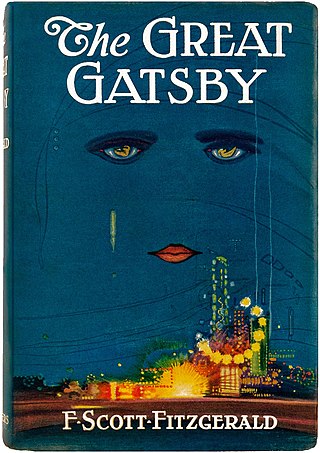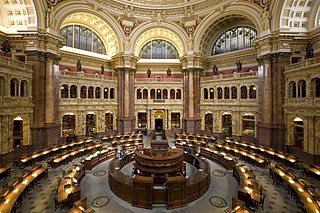
The Great Gatsby is a 1925 novel by American writer F. Scott Fitzgerald. Set in the Jazz Age on Long Island, near New York City, the novel depicts first-person narrator Nick Carraway's interactions with mysterious millionaire Jay Gatsby and Gatsby's obsession to reunite with his former lover, Daisy Buchanan.

American literature is literature written or produced in the United States of America and in the colonies that preceded it. The American literary tradition is part of the broader tradition of English-language literature, but it also includes literature produced in the United States in languages other than English.

Winesburg, Ohio is a 1919 short story cycle by the American author Sherwood Anderson. The work is structured around the life of protagonist George Willard, from the time he was a child to his growing independence and ultimate abandonment of Winesburg as a young man. It is set in the fictional town of Winesburg, Ohio, which is loosely based on Anderson's childhood memories of Clyde, Ohio.

Penelope Mary Fitzgerald was a Booker Prize-winning novelist, poet, essayist and biographer from Lincoln, England. In 2008 The Times listed her among "the 50 greatest British writers since 1945". The Observer in 2012 placed her final novel, The Blue Flower, among "the ten best historical novels". A.S. Byatt called her, "Jane Austen’s nearest heir for precision and invention."

Winnifred Eaton was a Canadian author and screenwriter of Chinese-British ancestry. Publishing prolifically under a number of names, most predominantly, the pseudonym Onoto Watanna, she was one of the first North American writers of Asian descent to publish fiction in English.

This Side of Paradise is the debut novel by American writer F. Scott Fitzgerald, published in 1920. It examines the lives and morality of carefree American youth at the dawn of the Jazz Age. Its protagonist, Amory Blaine, is an attractive middle-class student at Princeton University who dabbles in literature and engages in a series of romances with flappers. The novel explores the theme of love warped by greed and status-seeking, and takes its title from a line of Rupert Brooke's poem Tiare Tahiti.
Anne Tyler is an American novelist, short story writer, and literary critic. She has published twenty-four novels, including Dinner at the Homesick Restaurant (1982), The Accidental Tourist (1985), and Breathing Lessons (1988). All three were finalists for the Pulitzer Prize for Fiction, and Breathing Lessons won the prize in 1989. She has also won the Janet Heidinger Kafka Prize, the Ambassador Book Award, and the National Book Critics Circle Award. In 2012 she was awarded The Sunday Times Award for Literary Excellence. Tyler's twentieth novel, A Spool of Blue Thread, was shortlisted for the Man Booker Prize in 2015, and Redhead By the Side of the Road was longlisted for the same award in 2020.

Eleanor Stackhouse Atkinson was an American writer, journalist and teacher.

"Bernice Bobs Her Hair" is a short story by F. Scott Fitzgerald. It was first published in May 1920 in The Saturday Evening Post. It was Fitzgerald's first short story to achieve national prominence. The original publication featured interior illustrations by May Wilson Preston. The work later appeared in the September 1920 short story collection Flappers and Philosophers published by Charles Scribner's Sons.

"Head and Shoulders" is a short story by F. Scott Fitzgerald. It was his first story to be published in the Saturday Evening Post, with the help of Fitzgerald's agent, Harold Ober. The story appeared in the February 21, 1920 issue and was illustrated by Charles D. Mitchell. It later appeared in his short story collection Flappers and Philosophers.

"The Ice Palace" is a modernist short story written by F. Scott Fitzgerald and published in The Saturday Evening Post on May 22, 1920. It is one of eight short stories originally published in Fitzgerald's first collection, Flappers and Philosophers, and is also included in the collection Babylon Revisited and Other Stories.

Daisy Fay Buchanan is a fictional character in F. Scott Fitzgerald's 1925 novel The Great Gatsby. The character is a wealthy socialite from Louisville, Kentucky who resides in the fashionable town of East Egg on Long Island during the Jazz Age. She is narrator Nick Carraway's second cousin, once removed, and the wife of polo player Tom Buchanan, with whom she has a daughter. Before marrying Tom, Daisy had a romantic relationship with Jay Gatsby. Her choice between Gatsby and Tom is one of the novel's central conflicts. She was described by Fitzgerald as a "golden girl".

Francis Scott Key Fitzgerald was an American novelist, essayist, and short story writer. He is best known for his novels depicting the flamboyance and excess of the Jazz Age—a term he popularized in his short story collection Tales of the Jazz Age. During his lifetime, he published four novels, four story collections, and 164 short stories. Although he achieved temporary popular success and fortune in the 1920s, Fitzgerald received critical acclaim only after his death and is now widely regarded as one of the greatest American writers of the 20th century.
The following is a list of the Perry Mason novels and short stories by Erle Stanley Gardner, published from 1933 to 1973.

Ginevra King Pirie was an American socialite and heiress. As one of Chicago's "Big Four" debutantes during World War I, she inspired many characters in the novels and stories of writer F. Scott Fitzgerald; in particular, the character of Daisy Buchanan in The Great Gatsby. A 16-year-old King met an 18-year-old Fitzgerald at a sledding party in Saint Paul, Minnesota, and they shared a passionate romance from 1915 to 1917.

Taps at Reveille is a collection of 18 short stories by F. Scott Fitzgerald, published by Charles Scribner’s Sons in 1935. It was the fourth and final volume of previously uncollected short stories Fitzgerald published in his lifetime. The volume appeared the year after his novel Tender is the Night (1934) was published. The collection includes several stories featuring autobiographical creations derived from Fitzgerald’s youth, namely Basil Duke Lee and Josephine Perry.
Lucy Jane Bledsoe is a novelist who has received many awards for her fiction, including two National Science Foundation Artists & Writers Fellowships, a California Arts Council Fellowship, a Yaddo Fellowship, the American Library Association Stonewall Award, the Arts & Letters Fiction Prize, the Saturday Evening Post Fiction Award, the Sherwood Anderson Prize for Fiction, two Pushcart nominations, and the Devil's Kitchen Fiction Award. She is a six-time finalist for the Lambda Literary Award and a three-time finalist for the Ferro-Grumley Award.
"The Freshest Boy" is a short story by American writer F. Scott Fitzgerald. It was first published in the July 28, 1928 issue of The Saturday Evening Post, and was reprinted in Fitzgerald's 1935 collection, Taps at Reveille.
"First Blood" is a short story by F. Scott Fitzgerald, originally published in the April 5, 1930 issue of The Saturday Evening Post, illustrated by Harry Russell Ballinger. It was later included in his 1935 short story collection Taps at Reveille.
Alabama literature includes the prose fiction, poetry, films and biographies that are set in or created by those from the US state of Alabama. This literature officially began emerging from the state circa 1819 with the recognition of the region as a state. Like other forms of literature from the South, Alabama literature often discusses issues of race, stemming from the history of the slave society, the American Civil War, the Reconstruction era and Jim Crow laws, and the US Civil Rights Movement. Alabama literature was inspired by the latter's significant campaigns and events in the state, such as the Montgomery Bus Boycott and Selma to Montgomery marches.














